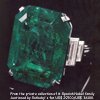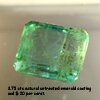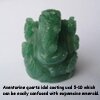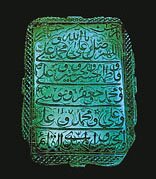 The word emerald brings to the mind the lush green color of a paradisiacal landscape. For thousands of years people have loved and admired the deep green color of the natural emerald gemstone, symbol of natural beauty, thus making it one off the most popular gems in spite of its brittle nature and difficulties found in setting the gem for emerald jewelry. Emerald Gemstone is also called as the May Birthstone.
The word emerald brings to the mind the lush green color of a paradisiacal landscape. For thousands of years people have loved and admired the deep green color of the natural emerald gemstone, symbol of natural beauty, thus making it one off the most popular gems in spite of its brittle nature and difficulties found in setting the gem for emerald jewelry. Emerald Gemstone is also called as the May Birthstone.
This gemstone gets it name from a Persian word, Esmeralde. In India it is know as Panna. In the history of emeralds the earliest know area where the natural emerald was found was Egypt, by the Red sea. The Egyptian emerald mines are in the hillside of Djebel Sikeit and Djebel Zabarah. Later, since high quality gemstones where mined from the Colombian mines, the Egyptian mines lost their importance (most were forgotten for many centuries). Big and precious roughs were also used in the form of emerald tablet. 
In fact, it is said that when the colombian emeralds were discovered, people preferred suffering torture or even dying than to reveal the source of the mines. Such was the beauty and quality of emarald gemstone that were found in Colombia.
 In ancient times (about 4000 BC in Babylon, the oldest known gem market), this fine quality emerald crystal gem was dedicated to the Goddess Venus. This gem represents immortality and faith, and thus a symbol for lovers who wish to express their undying love and faith. That is one of the reasons why it is one of the preferred stones for an engagement ring. Even on a wedding, they form a good contrast with the white wedding gown.
In ancient times (about 4000 BC in Babylon, the oldest known gem market), this fine quality emerald crystal gem was dedicated to the Goddess Venus. This gem represents immortality and faith, and thus a symbol for lovers who wish to express their undying love and faith. That is one of the reasons why it is one of the preferred stones for an engagement ring. Even on a wedding, they form a good contrast with the white wedding gown.
The emerald gemstone is one of the Navagraha stones (stones that represent the nine planets that have a cosmic influence on all earthlings) representing the Mercury (Budh) and is related to business, communication, intelligence, education and intuition.
The chemical formula of emerald gemstone is beryllium aluminum silicate (3BEO Al 2 O3 6 SiO2). It’s specific gravity is 2.67 to 2.78 and refractive index ranges between 1.56-1.57 and 1.59-1.60. It`s hardness on mohs scale is 7.5. Although this gemstone has a fairly good hardness it is highly brittle.
Emerald Gemstone is a variety from the mineral group beryl. The most famous gems from this group are the emerald and the aquamarine.
Emerald color
 It is the color of this gemstone that decides the emerald prices in the market. However, the cut, clarity and size of the gem are also deciding factors for the price of this gemstone. The deep green emerald color has always been the standard in grading all the other green colored gemstones. However there has been a disagreement among the experts in the field about the color of the emerald.
It is the color of this gemstone that decides the emerald prices in the market. However, the cut, clarity and size of the gem are also deciding factors for the price of this gemstone. The deep green emerald color has always been the standard in grading all the other green colored gemstones. However there has been a disagreement among the experts in the field about the color of the emerald.
Traditionally any fine green beryl colored by chromium was called an emerald, although a lighter variety of this gem should be rightly called as a green beryl. But then again there is a difference as to what color should be considered light, even though there have been master stone sets that the gemological laboratories use to classify it from a green beryl.
So one would wonder what the most desirable color of the emerald would be. The answer to this is a bluish green to green and the trace elements may vary between chromium, vanadium and iron. The presence or absence of any of these will bring in a color difference in the emerald.
Cut
 Emeralds are one of the most difficult gems to cut. The cutter should be extremely careful and plan the cut before he can start any process. Emeralds by nature have a lot of fractures (or cracks) in them and this makes the stone very brittle. Then the cutter need to make sure that the gem is cut in such a manner that the best of color, clarity along with minimum wastage (to retain the maximum weight of the stone.) is retained.
Emeralds are one of the most difficult gems to cut. The cutter should be extremely careful and plan the cut before he can start any process. Emeralds by nature have a lot of fractures (or cracks) in them and this makes the stone very brittle. Then the cutter need to make sure that the gem is cut in such a manner that the best of color, clarity along with minimum wastage (to retain the maximum weight of the stone.) is retained.
Custom faceted cuts are rare since the stone is extremely brittle. A very famous style of fashioning an emerald is a kind of step cut where the top or table is square or rectangular. The opposite facets are parallel to each other. The corners of the stone are cut off making the stone stronger and durable. Owning to the common use of this cut for emeralds this is now known as the Emerald Cut. Emeralds are also commonly cut and used in jewellery as cabachons, oval, princess etc. Many times the rough emaralds are polished and set in jewelry .
Carat
In colored stones transparency and clarity are closely linked. This is especially true with emeralds. Emeralds are normally found to have visible inclusions. Thus it is an accepted practice in the market to sell emeralds with inclusions or flaws. This makes an eye clean emerald very valuable. However, if the inclusion reduces the transparency and clarity of the gemstone completely or partially, the gem may not fetch a very good price in the market.
Clarity
Emerald gemstone come in varying sizes. The Kunsthistorisches Museum in Vienna (Austria) has a 2680 carat emerald vessel from Colombia on display. The very beautiful 75.47carats Hooker emerald is mounted on a diamond brooch by Tiffany and Co. and is named after one time owner Janet Annenberg Hooker. Where as on the other hand the Sandawana mines from Zimbabwe is known for its tiny size emerald the smallest of all sizes being one millimeter. A large size emerald is rare thus the price per carat of the gem will significantly go up with the increase in the size of the gem.
 Unlike most of the other colored stones, the price of emerald gemstone mostly depend on its color, followed by the clarity, size and cut of the gem. Emerald color has always been the standard for grading all the other green-colored gems. Bluish green to green is the most desirable color in emeralds. Presence of yellow or too much of blue can bring down the price of the stone very much. The color should be evenly distributed throughout the stone, with no eye-visible zoning. Also, as the thumb rule, transparent stones are more expensive than included ones. A high transparency and a good color can command very high prices for an emerald
Unlike most of the other colored stones, the price of emerald gemstone mostly depend on its color, followed by the clarity, size and cut of the gem. Emerald color has always been the standard for grading all the other green-colored gems. Bluish green to green is the most desirable color in emeralds. Presence of yellow or too much of blue can bring down the price of the stone very much. The color should be evenly distributed throughout the stone, with no eye-visible zoning. Also, as the thumb rule, transparent stones are more expensive than included ones. A high transparency and a good color can command very high prices for an emerald
 To cite an example of how the color and clarity of a stone can make it so valuable, in 1998 a 5.16 carat untreated, slightly bluish green eye clean Colombian emerald was sold at twice the rate of a diamond the same size and of highest quality! But in the normal market emerald can cost anywhere from usd 10 per carat to usd 3000 per carat depending on whether it is small, medium or large or has an unmatched grade.
To cite an example of how the color and clarity of a stone can make it so valuable, in 1998 a 5.16 carat untreated, slightly bluish green eye clean Colombian emerald was sold at twice the rate of a diamond the same size and of highest quality! But in the normal market emerald can cost anywhere from usd 10 per carat to usd 3000 per carat depending on whether it is small, medium or large or has an unmatched grade.
While buying a specific piece, all details of the emerald should be checked. If you are buying one to be set inside wedding jewelry, you may want to check out the heart shape designs. Make the choice based on various aspects mentioned above – color, cut, carat and clarity. You can also ensure that you have fancy sahpes and include teat drop, oval and other shapes.
Top quality special emeralds come from Colombia. Till date Colombian emeralds fetch the most unbelievable prices in the global market. This gem is also found in India, Zambia, Pakistan, Afghanistan, Russia, South Africa, Egypt, Zimbabwe, Austria, Brazil, Australia, Tanzania and Madagascar. Out of almost 16 source countries that have emerald mines only two countries actually mine them. 14 countries import rough stones from mining countries, cut and treat the rough and export faceted stones or import cut stones and export them to buyers around the world.
The emerald cutting centers are mainly based in Thailand and India. The largest emerald purchasing counties, accounting for almost 75% of the total purchase in the world are US and Japan.
The most common treatment carried out on emeralds to enhance the stone is oiling. Many fillers are also used along with the oil. The natural emerald crystal is soaked in colored as well as colorless oil or resins for a particular amount of time. Many a times the oil may be heated, so that it seeps well in the fractures of the gems. This helps to fill in emerald factures to make it look like a less included gem and enhance its color.
Although oiling is an accepted trade practice, treatment with colored oil, resin or any other filler should be disclosed before selling, as it can drastically bring down the price.

Some gemstones of lower value that could be confused with the natural green colored emerald are as follows: green beryl, tsavorite Garnet, zircon, green sapphire, tourmaline, chalcedony, aventurine quartz, synthetic emerald, dioptase, fluorite and paste.
Synthetic Emerald
Emerald Gemstone had been synthesized in the laboratory several times by earlier scientists, but the first commercial synthetic emerald production was accomplished by Carroll Chatam around 1940. Even in 1961, a product developed by Johann Lechleitner of Austria was introduced by the Linde company as the 'Linde Synthetic Emerald'. Large crystals of over 1000 carats have been made by Chatham and later by Gilson. Cut gemstones of over 5 carats are commonly available in the market.
 The cost of synthetic emerald or lab created emerald that is commonly found in the market is much lower than the natural ones. Synthetic emeralds may cost anywhere between $1- per carat to $150- per carat depending upon its quality and closeness to its natural counterpart. Synthetics are invariably very transparent and have the best green color. With the un-aided eye it is very difficult to distinguish the synthetic emeralds from the natural ones. If in doubt, it is always better to get the stone tested at a reputed gem testing laboratory.
The cost of synthetic emerald or lab created emerald that is commonly found in the market is much lower than the natural ones. Synthetic emeralds may cost anywhere between $1- per carat to $150- per carat depending upon its quality and closeness to its natural counterpart. Synthetics are invariably very transparent and have the best green color. With the un-aided eye it is very difficult to distinguish the synthetic emeralds from the natural ones. If in doubt, it is always better to get the stone tested at a reputed gem testing laboratory.
 This emerald named Mogul Emerald (one of its kind in history) weighing 217.80 carats, with one of its sides inscribed with prayers and the other side engraved with flower motifs was sold by Christie’s of London for 2.2 million dollars.
This emerald named Mogul Emerald (one of its kind in history) weighing 217.80 carats, with one of its sides inscribed with prayers and the other side engraved with flower motifs was sold by Christie’s of London for 2.2 million dollars.
The emerald birthstone is lucky for those who are born in the month of May. Hence it is also called as the May Birthstone.
Trapiche emeralds are found in both the chivor and the penas Blancas mines of the Muzo District.
Reference
1) Webster
2) Gemmology by Peter G.Read
3) Handbook of Gem Identification - Richard T.Liddicoat, jr
4) Gems and Crystals - From the American Museum of Natural History - Anna S.Sofianides and George E.Harlow.
Home | Add URL | About Us | Contact Us | Links | Privacy Policy | Resources | Sitemap | Design by Paper Tree
Copyright 2007 GehnaBazaar.com. All rights reserved. The information contained in this webpage may not be published, broadcast, rewritten or redistributed without a prior written consent. Natural Gemstones | Precious Gemstones | Jewellery Designers | Jewelry Institutes | Jewelery Design Institutes | Gemstone Information | Diamond Information | Gemmological Laboratories | Gem Labs | Jewelry Articles | Gold Price | Jewel Store | Buy and Sell Jewellery | Jewery Classes | Deisgn classes | Gemologists | Diamond Price